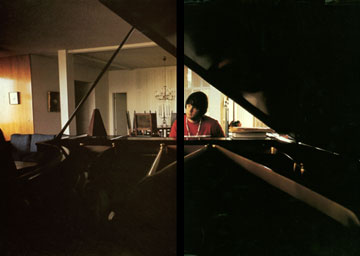 |
|---|
The Opposites
characteristic that may indicate
Satori (spiritual enlightenment)
or perhaps
something learned during
the religious experience.
The Opposites"It is useless to attempt to drag Zen down to the intellectual plane....
Zen belongs to the intuitive plane. It is therefore beyond discussion, and beyond the sway of the "opposites" by which all description and argument are carried on. It must therefore be understood on its own plane or not at all, for the intellect can never understand or assimilate spiritual facts."
~C. Humphreys, Zen Buddhism, (pg. 4.)"There's no way it could be made sensible and logical. It doesn't follow any pattern you could trace."
~Mike Love"...reality is grasped only when the intellect quits its claim on it. Zen knows this and proposes as a koan a statement having some savor of intellection, something which in disguise looks as if it demanded a logical treatment, or rather looks as if there were room for such treatment."~D.T.Suzuki, Zen Buddhism and Psychoanalysis, (pg. 49.)
No one has ever been able to logically explain SMiLE (early in 1997 my logical treatment of SMiLE reached an insurmountable impasse. A Beach Boys authority even advised me to give up the search and simply "enjoy the music.")
"(koans)will no doubt tax one's intellect to the highest degree of tension, finally making him characterize them all as utterly nonsensical and not worth wasting his mental energy on."~Zen Buddhism and Psychoanalysis, (pg. 50.)

Brian's piano room. Notice the picture on wall to the far left.
SMiLE is a koan, an expression of satori.
"Satori may be defined as an intuitive looking into the nature of things in contradistinction to the analytical or logical understanding of it. Practically, it means the unfolding of a new world hitherto unperceived in the confusion of a dualistically-trained mind....Logically stated, all its opposites and contradictions are united and harmonized into a consistent organic whole."
~Zen Buddhism: Selected Writings Of D.T. Suzuki, (pg. 84.)"As Satori lies beyond the intellect, which alone can define and describe, one cannot define Satori. It is that condition of consciousness wherein the pendulum of the Opposites has come to rest, where both sides of the coin are equally valued and immediately seen."~C. Humphreys, Buddhism, (pg. 185.)
The opposites. From right to left-yin and yang.The SMiLE Shop album cover pictures the male and female opposites. Brian Wilson's photo in the SMiLE booklet is a mirror image opposite.
Lyrically there are "mother and father," "heroes and villains," "boys and girls," "lost and found," "in and out," "up and down," and "now and then."
There are also the thematic opposites. The first movement is Brian's negative trip experience and the third movement is Brian's positive trip experience. The first movement represents Brian prior to his enlightenment and the third movement represents Brian after his enlightenment. The second movement opens with "Wonderful" about a young female growing up to find God and closes with "Surf's Up" about a male growing younger to find God. Culinary-wise, "Barnyard" is the first movement's 'meat' to the third movement's "Vega-Tables." SMiLE opens with a battle, "Heroes And Villains," and closes with "I Love To Say Dada/In Blue Hawaii," which represents peace (see Peter Reum's SMiLE Shop essay for more on this).
"Buddhist enlightenment consists simply in knowing the secret of the unity of opposites- the unity of the inner and outer worlds..."~Alan Watts, Buddhism:The Religion Of No-Religion, published 1996, (pg. 80.)There are also the "inner and outer" opposites ("within you" and "without you" in Beatle language.) These lie on opposite sides of the ego, the "I" and the "not-I." To let go of one's ego is to realize the unity of these opposites. The inner "I" and the outer universe(the"not-I") are unified in The Elements.
"It (satori) is the plane whereon Jijimuge is reality, where the whole is seen as such and its parts in their due proportion."~Buddhism, (pg. 186.)
"Jijimuge...means finding the Universal Buddha in every particular thing....all "thou's", or apples, or boats, are not only THAT but directly each other, completely and altogether."~Buddhism, (pg. 151.)
The Lava Lite is wind chimes. Wind chimes are the Lava Lite.
"...the apple is an apple none the less for being a boat, and the boat is a boat for all its appleness, or grand-piano-ness or cup-of-tea-dom."~Zen Buddhism, (pg. 152.)
The fire trucks are the iron horse. The iron horse is the fire trucks.
"...a chair is a chair and it is also not a chair (although we can chose to call that particular pattern of atoms at that particular moment by the word chair) and a human being is certainly a human being (for example, he will react if pinched), but he is also not a human being but only a temporary vibrational design formed by his position in space and time."~Zen For Beginners, pub. 1986, (pg. 52.)
The sunrise is a rainbow. The rainbow is a sunrise.
SMiLE scholars often cite the use of both lyrical and visual puns. The alternating images of Carl and Dennis from the American Band video's SMiLE segment, for example, can be seen as a visual pun.

R. H. Blyth, however, would most likely dismiss this pun-Zen connection.
"For Zen the most important thing in these lofty ethical pronouncements is the paradox itself. A paradox is not a kind of pun, to be resolved by explaining the double meaning of the word. It does not spring from a desire to mystify the hearers or oneself. It arises from the inability of language to say two things at once."
~Zen In English Literature And Oriental Classics, (pg. 180.)"You can get hung up in words, you know. Maybe they work; I don't know....If they don't get the words, they'll get the music, because that's where it's really at, in the music"~Brian Wilson
Blyth continues, "In this way music is greater than language. We can say two things at once, and the two separate melodies become one single indivisible harmony."~Zen In English Literature And Oriental Classics, (pg. 180.)
"...the doorknob is the cat and the cat is the doorknob, but though they are both interfused in one they never cease to be the doorknob and the cat respectively. Which is absurd, but Zen."~Zen Buddhism, (pg. 115.)
"But Zen is neither; it knows that whether one turns inward or outward one is the same. Both inner and outer are illusion; meanwhile here is a cup of tea, which is out, and my love of it, which is in, so why all these long words and furious distinctions? The glory is here, and now, and this; we need not look for it in the East or West."~Zen Buddhism, (pg. 205.)
SMiLE is about it, Oneness, the moment, the absolute, the eternal now, the ultimate religious experience, cosmic consciousness, one thought, God ("It's just a word, anyway.")
"This is a mystery and a miracle, but according to the Zen masters such is being performed every day. Satori can thus be had only through our once personally experiencing it."~Zen Buddhism: Selected Writings Of D.T. Suzuki, (pg. 84.)
"The principle is that all dualities and opposites are not disjoined but polar; they do not encounter and confront one another from afar; they exfoliate from a common center. Ordinary thinking conceals polarity and relativity because it employs terms, the terminals or ends, the poles, neglecting what lies between them. The difference of front and back, to be and not to be, hides their unity and mutuality."~Alan Watts, The Joyous Cosmology, (pg. 48.)
"For what consciousness overlooks is the fact that all boundaries and divisions are held in common by their opposite sides and areas, so that when a boundary changes its shape both sides move together. It is like the yang-yin symbol of the Chinese—the black and white fishes divided by an S-curve inscribed within a circle. The bulging head of one is the narrowing tail of the other."~The Joyous Cosmology, (pg. 50.)
"According to Buddhism, the notion of an ego, that is, awareness of oneself as a discrete individuality, is an illusion. It arises because, misled by our bifurcating intellect(the sixth sense) into postulating the dualism of "myself" and "not-myself," we are led to think and act as though we were a separated entity confronted by a world external to us." ~Philip Kapleau, The Three Pillars Of Zen, (pg.363.)
SMILEY SMILE begins and ends with opposites. "Heroes And Villains" is the opener and "Whistle In," with its daytime-nighttime theme, is the closer.




